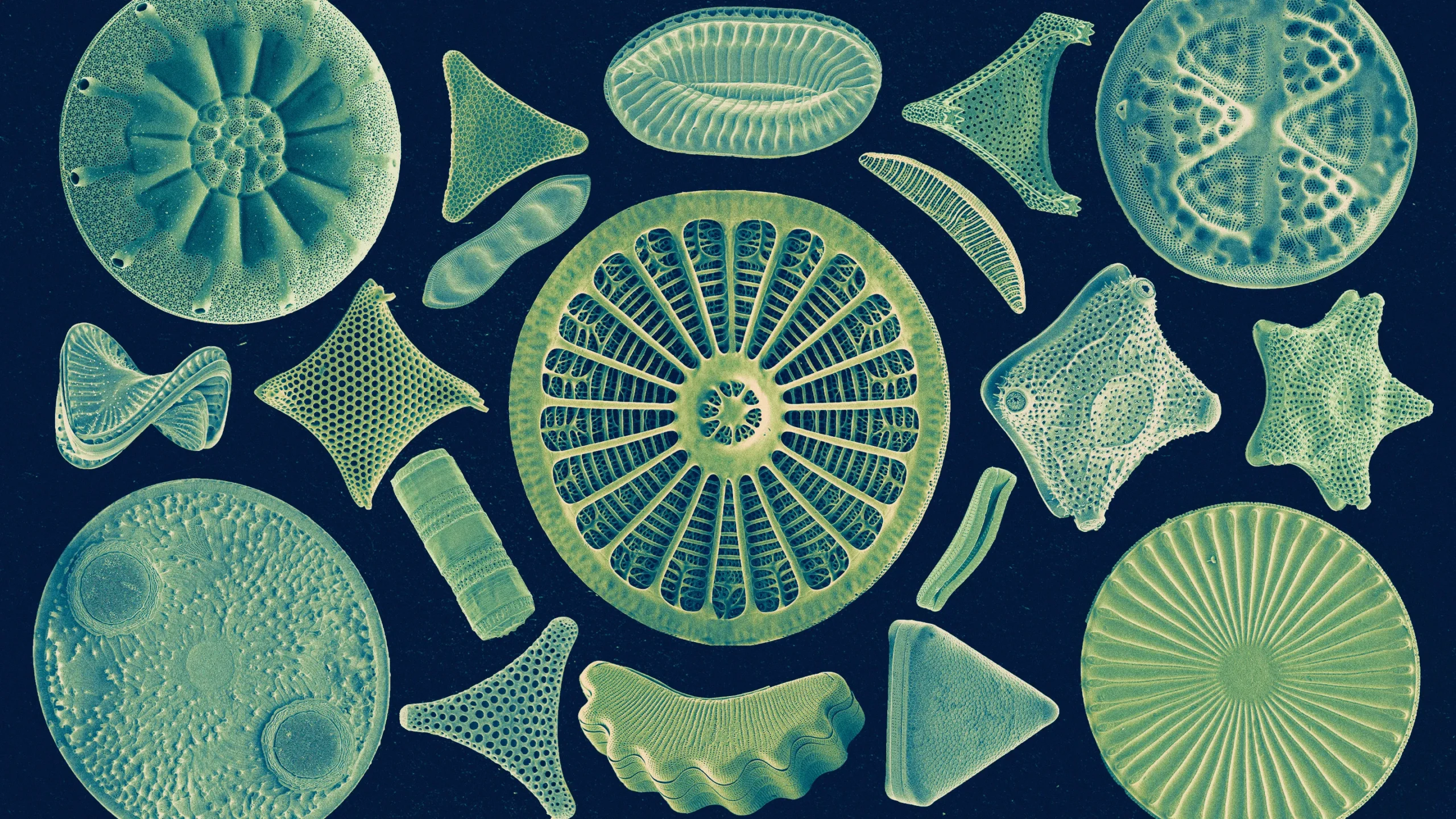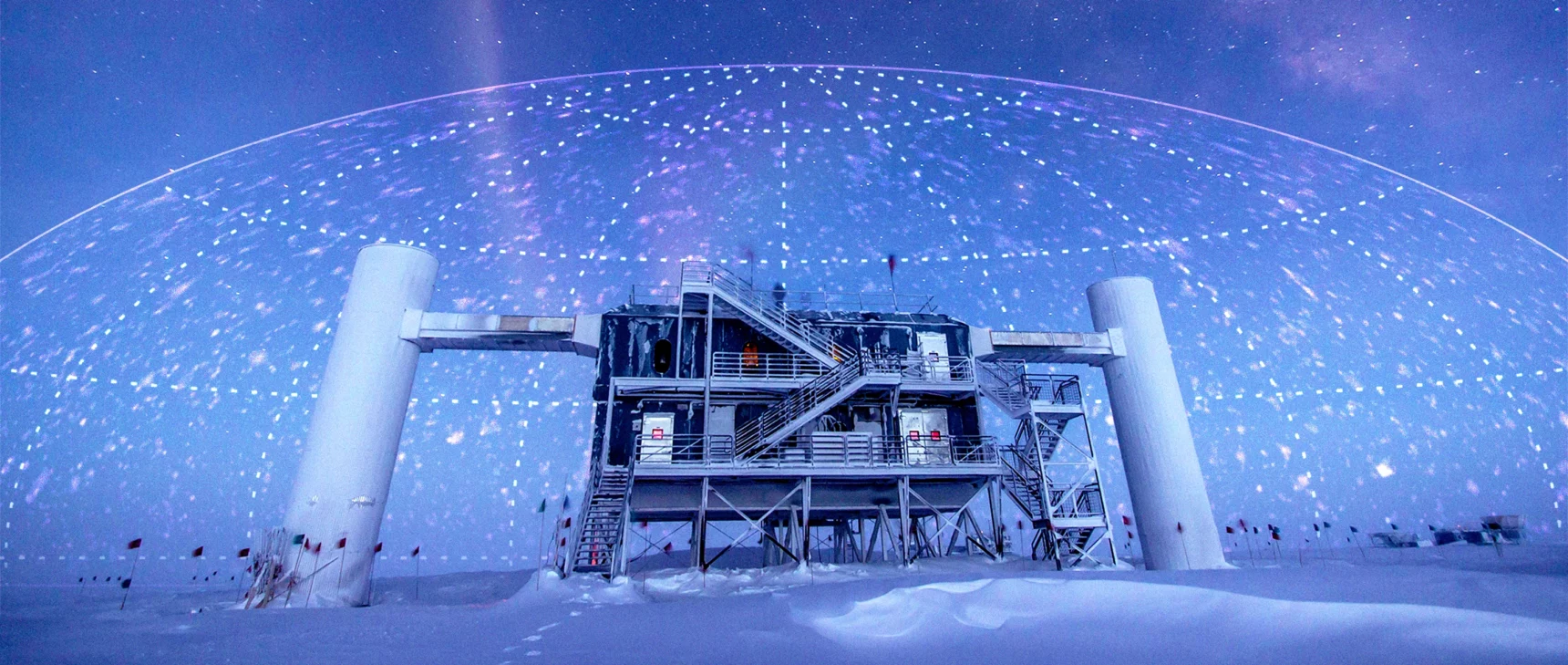Microbes Gained Photosynthesis Superpowers From a ‘Proton Pump’

The diverse and intricately shaped aquatic microbes called diatoms are extraordinarily effective at converting carbon dioxide into organic molecules through photosynthesis.
Steve Gschmeissner/Science Source; modified by Quanta Magazine
Introduction
A dense rainforest or other verdant terrestrial vegetation may be what first comes to mind at the mention of photosynthesis. Yet the clouds of phytoplankton that fill the oceans are the major drivers of that process in nature. The plantlike single-celled aquatic microbes generate more than 50% of the oxygen in the atmosphere, and they absorb nearly half of the carbon dioxide, converting it into the glucose, fats, proteins and other organic molecules that nourish the food web of the oceans.
A recently published study in Current Biology finally pins down the source of this unparalleled photosynthetic efficiency, which has long baffled scientists. The new research found that some phytoplankton are equipped with an extra internal membrane that carries a “proton pump” enzyme that supercharges their ability to convert carbon dioxide into other substances. The enhancements due to this one protein modification seem to contribute to the production of nearly 12% of the oxygen in the air and as much as 25% of all the carbon “fixed” (locked into organic compounds) in the ocean.
Surprisingly, that photosynthetic innovation seems to have evolved by chance from a membrane protein that was originally used for digestion in the ancestor of the phytoplankton. In addition to explaining the cells’ prowess at photosynthesis, the new work helps to confirm the theory that those phytoplankton arose through a symbiotic alliance between a protozoan and a resilient red alga.
“I find it staggering that a proton enzyme that we have known for so many decades is responsible for maintaining such a crucial phenomenon on Earth,” said Dennis Brown, a cell biologist at Harvard Medical School who studies the functions of membrane proteins and was not involved in the study.
Researchers knew that certain classes of phytoplankton — diatoms, dinoflagellates and coccolithophores — stand out for their exceptional photosynthetic abilities. Those cells are extremely proficient at absorbing carbon dioxide from their environment and directing it to their chloroplasts for photosynthesis, but the details of why they are so good at it haven’t been very clear. A feature unique to those three groups of phytoplankton, however, is that they have an extra membrane around their chloroplasts.
Seven years ago, the microbiologist Daniel Yee, the lead author on the new study, was studying diatoms for his doctorate at the Scripps Institution of Oceanography at the University of California, San Diego. Photosynthesis wasn’t his focus; he sought to understand how diatoms regulate their internal acidity to help with nutrient storage and to build their tough silica cell wall. But he kept noticing the unique additional membrane around their chloroplasts.
He learned that the extra membrane was widely regarded by researchers as a remnant of an ancient, failed act of digestion. Scientists hypothesized that about 200 million years ago, a predatory protozoan tried to feast on a single-celled photosynthetic alga. It enveloped the resilient alga in a membrane structure called a food vacuole to digest it, but for unknown reasons, digestion did not occur. Instead, the alga survived and became a symbiotic partner to the protozoan, feeding it the fruits of its photosynthesis. This partnership deepened over the generations until the new two-in-one organism evolved into the diatoms we know today. But the extra layer of membrane that had been a food vacuole never disappeared.
In the late 1990s, some scientists hypothesized that the former food vacuole was still likely to carry a transmembrane channel protein called a proton pump. Proton pumps are highly versatile molecules that can be specialized for diverse tasks in organisms, from digestion to regulating blood acidity to helping neurons send signals, explained the microbiologist Martin Tresguerres, the senior co-author of the new study and Yee’s former adviser at UCSD. In mammals, one type of proton pump can create highly corrosive acidic conditions within areas of bones to break down their mineralized structure and dissolve them over time.
Yee found that the same proton pump also helps diatoms make their tough silica shell. But considering the versatility of the proton pump and its direct association with the chloroplast, he was convinced that it did even more.
Using a combination of molecular biology techniques, Yee and his team confirmed that the extra membrane around the phytoplankton chloroplast does contain an active, functional proton pump — one called VHA that often serves a digestive role in food vacuoles. They even fused the proton pump to a fluorescent protein so that they could watch it work in real time. Their observations supported the endosymbiotic theory of how the diatoms acquired the extra membrane around their chloroplasts.
Yee, Tresguerres and their colleagues were also curious about how the proton pump might affect the photosynthetic activity of the chloroplast. To find out, they used an inhibitory drug, concanamycin A, to halt the operation of the proton pump while they monitored how much the phytoplankton continued to incorporate carbon into carbonates and produce oxygen. They found that inhibition of the proton pump significantly decreased both carbon fixation and oxygen production in the cells.
Further work helped them understand that the pump enhanced photosynthesis by concentrating carbon near chloroplasts. The pump transferred protons from the cytoplasm to the compartment between the extra membrane and the chloroplast. The increased acidity in the compartment caused more carbon (in the form of bicarbonate ions) to diffuse into the compartment to neutralize it. Enzymes converted the bicarbonate back into carbon dioxide, which was then conveniently near the chloroplast’s carbon-fixing enzymes.
Using statistics on the distribution of the diatoms and other phytoplankton with the extra membrane throughout the global ocean, the researchers extrapolated that this boost in efficiency from the VHA membrane protein accounts for almost 12% of Earth’s atmospheric oxygen. It also contributes between 7% and 25% of all the oceanic carbon fixed each year. That’s at least 3.5 billion tons of carbon — almost four times as much as the global aviation industry emits annually. At the high end of the researchers’ estimate, VHA could be responsible for tying up as much as 13.5 billion tons of carbon a year.
Scientists can now add this factor to other considerations when estimating the effects of climate change on how rapidly atmospheric carbon dioxide is fixed into organic molecules, which dictates how quickly the planet will continue to warm. It also bears on discussions about whether changes in ocean acidity will have a direct impact on the rates of carbon fixation and oxygen production. Yee said that scientists can also begin to ask whether biotechnology solutions based on the newly discovered mechanism could enhance the process of carbon sequestration to limit climate change.
Yee, who is now a postdoctoral fellow at the Cell and Plant Physiology Laboratory of the French National Center for Scientific Research in Grenoble, is proud that his team was able to provide a new mechanism for how photosynthesis occurs in such an ecologically important life form.
“But we also realize,” he said, “that the more we learn, the less we know.”
Correction, July 7, 2023:
An earlier version of this article described the cell that merged with a protozoan to create phytoplankton as a green alga. It was a red alga.



